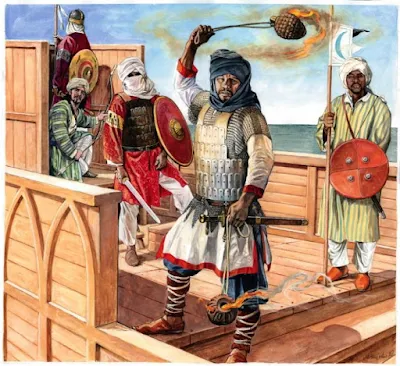
The Almoravids were a Muslim militia primarily composed of Berber and African Moors, and unlike previous Muslim rulers, they were not so tolerant towards Christians and Jews. Their armies entered the Iberian peninsula on several occasions (1086, 1088, 1093) and defeated King Alfonso at the Battle of Sagrajas in 1086, but initially their purpose was to unite all the taifas into a single Almoravid Caliphate.
 |
| Yūsuf ibn Tāshufīn |
Their actions halted the southward expansion of the Christian kingdoms. The Almoravid ruler Yūsuf ibn Tāshufīn entered the Iberian Peninsula from North Africa and slowly advanced to the fields of Al-Zallāqah, north of Badajoz (Baṭalyaws), where in 1086 he defeated a Castilian army under Alfonso VI.

However, unable to further exploit his victory, he returned to the Maghrib. For two years Almoravid policy in Spain remained indecisive, but it appears that the siege of Aledo (1088) convinced Yūsuf ibn Tāshufīn of the urgent necessity of putting an end to the ṭāʾifas if he was going to rescue Spanish Islam.
 |
| Almoravids Dynasty |
From 1090 he deposed their rulers, beginning with those of Granada and Málaga; the next year he dethroned the rulers of Almería and Sevilla, followed by the leader of Badajoz in 1093. He first served as a mercenary in the ṭāʾifa of Zaragoza, after which he became an independent prince in the east, ruling over states that were mainly inhabited by Muslims.
He had the good fortune, however of finding efficient administrators from among the Mozarabs residing in his states; further, his superb grasp of Almoravid tactics enabled him to overcome his numerical inferiority.
Catalonia came under intense pressure from the taifas of Zaragoza and Lérida, as well as from internal disputes, as Barcelona suffered a dynastic crisis that led to open war among the smaller counties. But by the 1080s, the situation had calmed down, and the dominion of Barcelona over the smaller counties was restored.
Yūsuf ibn Tāshufīn the rising power in North Africa, took over most of Al-Andalus and Spain
However, the conquest of Zaragoza marked the beginning of the Almoravid decline. The Aragonese king, Alfonso I (the Battler), and his stepson, Alfonso VII of Castile, launched renewed Christian assaults against the entire frontier of Islam in Spain.
 |
| Alfonso VII |
In 1118 Zaragoza fell into the hands of Alfonso I, who reconquered a large part of the valleys of the Jalón and of the Jiloca. After 1121 the Almoravids experienced serious difficulties in Africa as a result of the preachings of an Amazigh reformer, Muḥammad ibn Tūmart, and could not successfully withstand the Christian onslaught; indeed, they had to hire Christian mercenaries to help them.

A resounding Almoravid victory over the Aragonese at Fraga (Ifragah) in 1134 bore no fruit, because the Almoravids lacked the resources to exploit it. Alī ibn Yūsuf Upon his death, Valencia remained under the control of his forces until 1102, when they were forced to evacuate it and seek refuge in Castile.
READ MORE IN ENCYCLOPÆDIA BRITANNICA ABOUT THE ALMORAVID
By Parish Pascal
BINNABOOK PUBLISHERS.



0 Comments:
Post a Comment
Your Views are needed.Thanks!